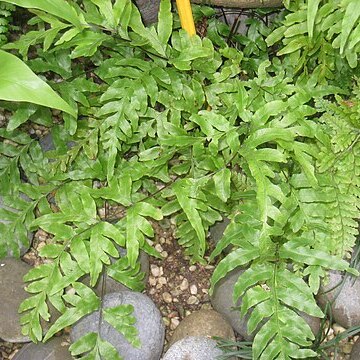Plants 35-80(-120) cm tall. Rhizome long creeping, 1-1.5 cm in diam., apex with blackish brown scales; scales also at base of stipes. Fronds clustered, submonomorphic; stipe 15-55 × 1.5-3 cm, stipe and rachis castaneous-reddish, shiny, glabrous; lamina pinnate, oblong-lanceolate in outline, 15-40(-60) × 6-15(-18) cm, at one side deeply bipinnate-lobed; lateral pinnae 4-7 pairs, opposite or subalternate, spreading, basal pairs shortly stalked; upper ones sessile; lamina half-triangular and slightly falcate, 5-10(-18) × 4-7 cm, basiscopic side pectinately lobed nearly to costa, acroscopic side reduced to subentire wing to 6 mm wide, base oblique, basiscopic side decurrent, apex caudate-acuminate; basiscopic segments 3-6 or more, falcate-lanceolate, basal part longest, 1.5-4(-8.5) × 0.3-0.6(-1.1) cm, basally margins of sterile segments acutely serrate, fertile segments entire except for with 1 spine or 2 or 3 acute teeth near apex, apex mucronate or obtuse; terminal pinna pectinately divided almost to rachis, broadly lanceolate to narrowly triangular in outline, 10-18 × 3-10 cm, apex caudate; segments 6-12 pairs, opposite, spreading, 3-5 mm apart, falcate-lanceolate, 2.5-5 × 0.6-1 cm, upper ones gradually reduced, basiscopic obtriangular wing decrescent to next pair of pinnae along costule, apex shortly acuminate; costae prominent abaxially, chestnut adaxially, distally straw-colored, grooved adaxially, grooves with thin, minutely and irregularly toothed, raised edges. Veins conspicuous, decumbent, 2-forked or bipinnate-forked, veinlets reaching base of teeth; lamina gray-green, herbaceous when dried, glabrous. 2n = 116.
More
Rhizome short, ascending, scaly. Fronds monomorphic. Stipe 20–40 cm long, dark purple, glossy. Lamina oblong, 1-pinnate, 30–40 cm long, with 5–9 pairs of pinnae, chartaceous, glabrous; basal pinnae with a broad continuous wing on the acroscopic side, incompletely 1-pinnate-pinnatifid on the basiscopic side. Ultimate segments 2–5 cm long, 5–12 mm wide; sterile margins sharply serrate; apex acute; veins free, once-forked.

